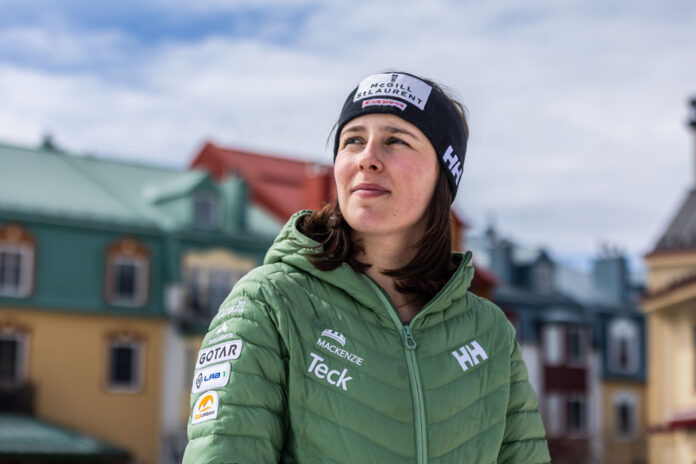(Mont-Tremblant) To undergo or not to undergo the operation? There is the question.
At the beginning of January, somewhere on a European slope, Sarah Bennett was winding at high speed between the gates on a slalom descent.
And since these athletes race at a speed too far from reason to allow Sunday skiers to even imagine the risks involved, the slightest contact, or the slightest deviation, can be fatal.
And by passing too close to a rod, his shoulder took the full force of the impact.
The 22-year-old skier, in the midst of her first season with the national team, had just suffered a torn shoulder joint (acromioclavicular).
“I put my hand in and at first I thought it was a dislocation of the clavicle,” says Bennett, in the Mont-Tremblant travelers’ chalet.
“I told everyone, ‘Put it back to me, it hurts!’” Because my collarbone was out. And there, they told me: “No, we can’t”. »
The options were therefore limited for the Stoneham athlete. “Either have surgery and end my season or not have surgery and risk complications, but be able to ski the following week. »
Completely disoriented, she searched almost all the names in her address book. Family, friends, teammates, doctors. And neither choice was unanimous. Until her teammate Kiki Alexander reasons with her.
“[She] was injured four days before me. I asked her what she would do. And she told me to think about the long term and that if I were me, she would do the surgery,” Bennett recalls.
On the way to a medical consultation in Ottawa, sitting next to her father in the car, the skier finally made up her mind: “We drove an hour and I looked at my father. I told him I thought we should do the operation. We changed course and two days later, I had surgery. »
For Bennett, the upcoming season is therefore “a new beginning”. Last year, as a rookie, she took part in only three World Cups and she never survived the loss of the first round.
“It almost seems like I needed that injury to wake me up to how lucky I was. Before my injury, I had no results to hold on to. So I was just in limbo. »
The giant is the greatest project in Quebec alpine skiing since she was old enough to compete and she intends to respond positively to these expectations sooner rather than later.
To achieve this, it intends to rely more on its independence. If everything was new last year, she is now able to know what suits her.
“It’s about remaining independent and depending on who surrounds me, remaining true and faithful to myself and what I need. To trust the process, even when things go wrong. It’s more independence than last year, when I was really more dependent on my coaches than myself. »
For example, as she recovered well from her operation, she decided on her own, and thanks to sponsors, to go to California during the off season to get back on the snow as early as possible in her rehabilitation process.
“Otherwise there would have been too big a gap with the girls when they arrived at the team camp in Chile,” she thinks. It was for the search for independence. The only person in control is myself. »
Bennett will also have the luxury of being able to evolve in an environment more suitable for her. For several months, she has been training off-piste with Charles Castonguay, the same trainer as Laurence St-Germain.
“He really helped me. On a physical level, a lot of things have changed and as soon as I got back on snow, I felt it. »
Then on the snow, precisely, the promotion of Francis Royal, the former coach of Team Quebec, as manager of the Canadian women’s slalom team is a blessing for Bennett. She worked alongside Royal for four years on the provincial scene and the two understand each other almost without needing to speak.
The Quebecois excels in several, if not all, disciplines. However, his wish is to progress in the technical events, and Francis Royal knows it. She will start the season in giant slalom, but “I am given the opportunity to train a lot more in slalom. And with Francis, he knows it’s super important for me to continue doing slalom.”
Inspired by Petra Vlhová and Laurence St-Germain, Bennett really has the skills to hope for success in slalom, as in all the categories she has competed in before.
With the Canadian team having a historic season last year, the “team standards are extremely high,” she says.
And although she is fully recovered from her injury, for someone who has been sidelined for a considerable period of time, “it’s not ideal.”
But really, what is the ideal?
According to writer Bernard Werber, it is a mixture of three elements: work, luck and talent. Bennett loves the former and overflows with the latter. All that’s missing is luck.
And she plans to grab hers as quickly as possible.















